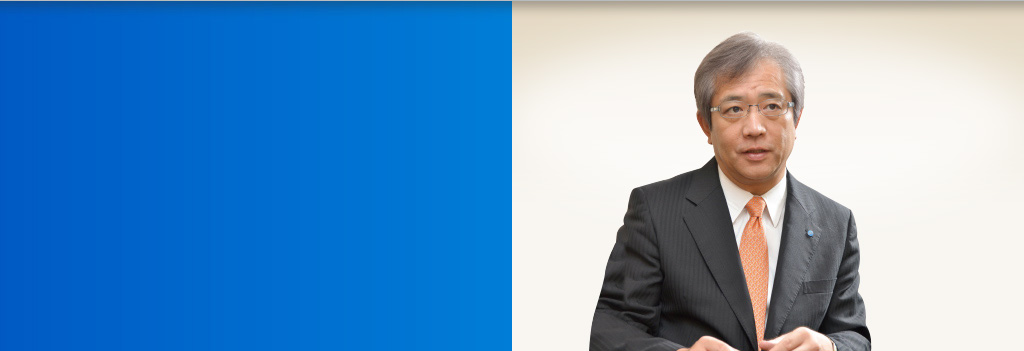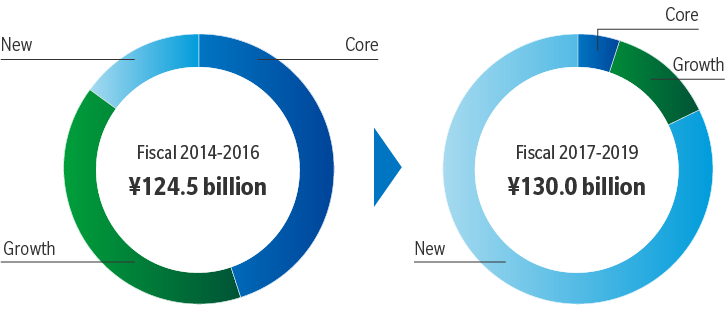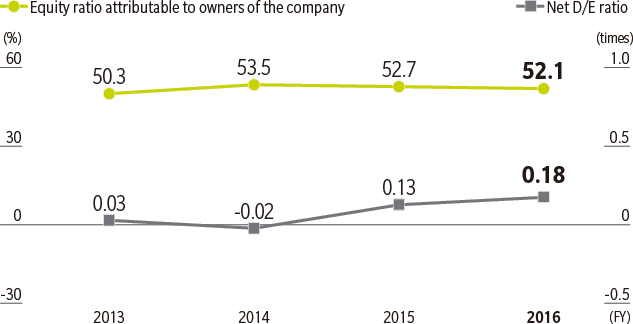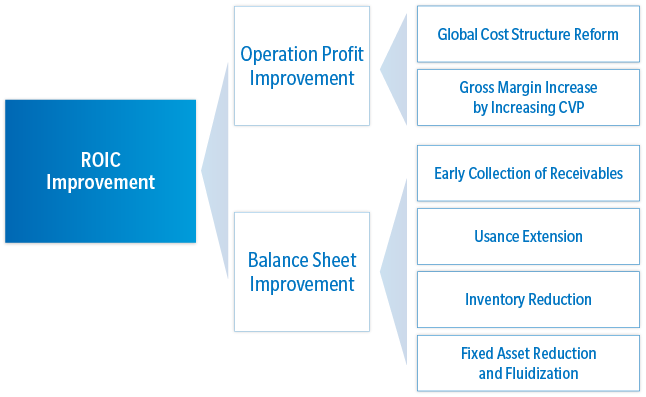Message from the CFO
Our goal is to build the optimal financial foundation with a view to both business expansion- and reinforcement-oriented activities.
Seiji Hatano
Senior Executive Officer
Our goal is to build the optimal financial foundation with a view to both business expansion- and reinforcement-oriented activities.
Seiji Hatano
Senior Executive Officer

For Konica Minolta to achieve medium- to long-term growth as a high-profit company, it will be essential to create new businesses while reinforcing and expanding growth businesses. We see M&A as an important step in making this possible. Under the previous Medium Term Business Plan, TRANSFORM 2016, we conducted a large number of M&A in each of our business segments with the goal of more quickly transforming our business portfolio.
We take full advantage of Konica Minolta's strengths, technical expertise, portfolio assets, and other resources at the planning stage of every merger or acquisition and analyze the areas where we can best achieve synergy. In order to ensure a more seamless and complete postmerger integration (PMI), we conduct thorough preliminary surveys that focus not only on business compatibility but also on that company's management philosophy, vision, corporate culture, and other aspects. Our M&A process involves a multifaceted consideration of many things, including that company's affinity with Konica Minolta's business strategies, the feasibility of business plans, the suitability of investment amounts, profitability, safety, and the business management system that will result following the acquisition.
The acquisition of Ambry Genetics Corporation, which was announced in July 2017, was a major project that resulted from these decision-making standards. We chose Ambry Genetics because it best fit our overall strategy as determined through painstaking research that looked at multiple companies with technologies and expertise in precision medicine that Konica Minolta did not have.
In addition to the normal executive functions they perform, the Investment Assessment Committee and the Business Assessment Committee, which I chair, examine every merger, acquisition, or other investment project from all sides. For the acquisition price, we use the net present value (NPV) indicator to calculate the current value of the investee based on the cash flows during the investment period. We then take a well-rounded look at their business plans, considering such things as how many times more the acquisition price is than the profit, as well as the length of the payback period. After the merger or acquisition, we conduct a thorough PMI with the goal of further enhancing corporate value through Group synergy.
Konica Minolta adopted the IFRS international accounting standards beginning with its fiscal 2014 annual securities report, and always conducts impairment tests once a year. As with other impairment tests, during the fiscal 2016 impairment test we received approval from an auditing firm that none of our Group companies should declare impairment.
As with previous plans, the new Medium Term Business Plan launched in April 2017, SHINKA 2019, states our intention to establish an investment and loan limit of ¥130 billion over three years for future growth and to prioritize allocation to new business domains.

One of my primary responsibilities as CFO amid Konica Minolta's avid efforts to make growth-oriented investments will be to maintain our credit rating while at the same time both minimizing financial risk and maximizing capital efficiency. This prompted the building of the Global Cash Management System during the previous Medium Term Business Plan period. This entailed creating a treasury management system, visualizing capital, improving capital prediction accuracy, deploying a cashless system for payments made between affiliated companies, consolidating exchange rate risk management, and other efforts as part of the construction of a sophisticated global financial management platform. This system of cash management has earned Konica Minolta high praise from financial institutions and other companies' finance departments.
Meanwhile, we are also monetizing the assets in our possession. As a result of efforts to maximize the value of our intellectual property rights, in fiscal 2016 we recorded ¥7.8 billion in the third quarter as compensation for the license to exercise patent rights in the field of optical systems for industrial use. Under our corporate real estate (CRE) strategy, in 1Q FY2017 we procured ¥4 billion by liquidating (via sale and leaseback) a portion of the real estate we held in Japan. This represents the product of making optimal use of the facilities (land and buildings) for which we have given consideration in recent years with a view to global business expansion.
We will continue to implement these measures while maintaining financial discipline, keeping the shareholders equity ratio at 50% or above, and aiming to achieve a net debt-to-equity ratio of 0.1 over the medium-term.

The new Medium Term Business Plan seeks to achieve a 9.5% ROE by fiscal 2019. In concert with the goal of imparting greater added value to our business departments in order to strengthen earning power, I will be implementing four measures as CFO.
The first of these will be thorough balance sheet management. Due to the significant differences among our businesses concerning such aspects as accounts receivable, inventory size, and payback period, we have been carefully checking each business's cash conversion cycle and conducting balance sheet management that is optimal for each business. In fiscal 2018, we will begin to further improve capital efficiency while strengthening each business site’s ability to independently execute by implementing business unit-specific return on invested capital (ROIC) management with core businesses as the main focus. Along with promoting voluntary improvement activities at our business sites, we will be carrying out an earnings growth strategy that strikes a balance between growth and efficiency by using both the operating profit ratio and balance sheet as indicators.
The second measure will be working style reform with the use of IT and AI in order to improve business productivity. As an example, the streamlining of business processes using robotic process automation (RPA) is being considered for even finance departments.
The third measure is improving our readiness for exchange rate volatility. Although the value of the yen against the dollar has little effect on our business, we incur ¥1.2 billion in losses when the yen goes up one point against the euro and other European currencies. We have therefore been adversely impacted by the stronger yen in recent years. In response, our plan during this new Medium Term Business Plan period is to push forward measures to expand euro-denominated procurement and sell products and services from European acquisitions to other regions, among others, in order to improve our exchange rate sensitivity to the euro and other European currencies.
The last measure is the formulation of the Group Tax Policy implemented in fiscal 2016. This policy accords with international taxation system reforms being made in response to the base erosion and profit shifting (BEPS) project recommended by the OECD and G20. By sharing this taxation policy with the public, we are working to build strong relationships with tax authorities in Japan and abroad while actively seeking to observe taxation rules and ensure transparency. I also see this as an opportunity to strengthen the Group's tax governance. As such, we will be optimizing our tax liability through means that include using IT systems to seamlessly collect tax information from Group companies worldwide and reducing double taxation risk.
